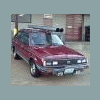Search the Community
Showing results for tags 'highway'.
-
(the subtitle "safe highway speeds" in the title pertains to engine rpm, not what one's opinion on what speeds are considered safe to travel. This thread isn't about driving habits or opinions on that matter, it is about information regarding gear ratios and engine reliability, maintainance, and engine speed sustainability) Over the years it's come to my attention on many occasions that a lot of people are put off by the (relatively) archaic gearing ea82 body cars have. I can't tell you how many posts I've seen on here of people questioning the high RPMS their car is turning at highway speeds (especially those with the 3 speed automatic transmission) I wanted to make this thread to document certain things I know through my own personal experience to be true, as well as to qualm any fears some people may have in regards to their vehicle and its ability to "Keep up with traffic" on today's highways. I've been driving ea82 vehicles for about 10 years now, and in those 10 years I've driven a good variety of their different formats: A 93 3 speed FWD SPFI Loyale I drove around for a good 6 years or so, both on the highway and in city driving. I took it to Canada and back from New Jersey An 87 dual range 4WD 5 speed carby GL I drove around for 3 years, both on the highway and in city driving. I drove that car across the country four times. An 86 push button 4WD 3 speed MPFI turbo GL-10 that is a current project I have that I have driven on the highway a few times and around town every now and then a 93 5 speed FWD SPFI Loyale that is currently my daily driver. I drive this car on the highway a-LOT, and around town a-LOT. In fact I drive this car....a-LOT. I've put 16,xxx on it over the past 10 months and 700+ miles on it just this past weekend. I am also an automotive mechanic and I am the sole person who has maintained each and every one of the above cars while they were owned by me. The key component to driving any of these old subarus around so much is to have confidence in them, and, knowing that I am the person responsible for their upkeep, that confidence is something I have never lacked, and I drive my cars accordingly. That being said; Regarding the 3 speed automatic cars, yes, you can do 70 mph in it. It's not going to explode. At least not unless it was going to for some reason or another anyway. I recommend that you stay on top of your oil changes (I use mobil 1 conventional 10/30 or 10/40 oil + filters year round in all my vehicles), and that you are confident in the condition of your timing belts and components. The issue here is that at 70 mph you're going to be running that lil ea82 at about 4,100 RPM. Now that's no big deal to the short stroke boxer motor itself (these engines are used in airplanes where they run high RPM for hours), but it's your alternator, your waterpump, and your timing belts and their pulleys and idlers that may complain here. If you just picked up a 92 Loyale with 38,000 miles on it that means it has slept a lot in it's 25 year existence. The bearings in that original alternator aren't going to like being subjected to you running the motor at 4,000 rpm for long. Neither is that super dried out and old timing belt. This goes for any other car, but the 3 speeds especially because of how poorly they are geared for highway use. So basically what I'm saying is that if you plan on using your 3 speed car on the highway, please make sure important components such as those I've mentioned are in good shape, and/or have spares at the ready. Also make sure the transmission fluid is in decent condition and the differential oil is as well. My real world experience with the 3 speed car on the highway is well over 10,000 miles. I drove that 3 speed loyale from NJ to Toronto doing 65-70 mph basically the whole way. It took a long time, but that was hours and hours and hours of sustained 4,000-ish rpms. And it'll get about 25 mpg at those speeds. I've also peaked a 3 speed auto at 100 mph @ 6,400 rpms. Out of curiosity. I've also driven a 3 speed auto car at speeds in excess of 75 mph for over 3 hours straight. Moving on to the 5 speed dual range 2 things; It is awesome. Please check your gear oil. I burned mine up because I drove it across the country twice without following my own advice. That being said it had no problem running 65, 70, 75, 80, 85 mph but my god the thing was gutless climbing those mountains out there. 3rd gear with my foot to the floor barely maintaining 55. This car taught me the lessons about low mile cars. I bought this 87 GL in 2012 and it only had 46,000 miles on it. I slapped plates on it, loaded it with people and stuff and took it from NJ to Nevada twice. The first trip I had 2 things happen; the water pump gave up the ghost as soon as my 5,000+ mile trip concluded and I was back in my hometown, and the 28 year old gear oil had (unbeknownst to me) turned to water and I fried the trans. I took it across the country again with fresh gear oil a second time and had no trouble, other than noise. Risky, but it did it. I still have that trans, and it still worked when I pulled it, just made lots of noise. I'm not even going to touch on the 3 speed push button in the turbo car because I don't drive it much. All I can say is that it seems to be geared differently than the FWD naturally aspirated car. 4,000 rpm is about 73 or so mph in it, whereas that would be 68-70mph in the FWD car. Last, and most extensively researched but surely not least is the FWD 5 speed in my daily driver Loyale. I have numbers due to recent curiosity: (All numbers are while in 5th gear) 3,450 rpm - 78 MPH 3,600 rpm - 80 MPH 3,900 rpm - 86 MPH 4,200 rpm - 89 MPH 4,500 rpm - 95 MPH 4,900 rpm - 98 MPH 4,950 rpm - 100 MPH 5,100 rpm - 106 MPH I find myself typically cruising at about 80-85 mph and my ea82 is humming along comfortably in the 3,600 - 3,900 rpm range. Right where the old 3 speed auto I used to drive would comfortably sit while I jostled along at 65 hahaha I find this convenient because anytime I notice I'm around 4,000 rpm, I know I'm going a bit *too* fast. I honestly find myself looking at the tach more than the speedometer. Once you get past that 4,500 rpm threshold though, two things happen: You lose the ability to (relatively) easily maintain speed (You can hold 95 without having to have your foot to the floor the entire time) and, you really start pushing the limits of your motor. I've run these engines at over 5,000 rpm for a couple hours and nothing catastrophic occurred, but I really would advise against anything over 4,500. Not to mention, there's no more power up there anyway. It all starts around 4,000 rpm and just rapidly drops off over 4,500. So to recap; 4,000 rpm = OK 4,500 rpm = Still OK! Over 4,500 rpm = Not smart. Make sure your timing belts and pulleys are good Maintain your vehicle HAVE GOOD TIRES (don't go flying around on dry-rotted tires from 1996) And every bit of information I shared in this post is entirely based on my personal experiences with various ea82 subaru vehicles over the course of the past decade. Your mileage very well may vary (And it probably will as the FSM shows a good bit of gearing variation through the 1985-1994 ea82 run).
-
At highway speeds, there is a vibration, feels like it's from the front, steering wheel cycles left-right about 5 times a second. I just had new tires put on. What besides tire imbalance can cause symptoms similar to tire imbalance? mkoch
-
I've noticed a very annoying thing lately. When I'm driving on the highway in 5th gear (MT) and apply full throttle I can feel the power increase from the VVL, but I notice that sometimes it pulses and doesn't want to apply smoothly. This causes a slight power surging and if I slowly let off the gas I feel a point that actually accelerates better with less throttle. Could this be a bad VVL solenoid, or something with the fuel mixture? Im at a loss. It seems like bad engineering to use two separate oil pressure sensors for the VVL system since oil pressures could be different on the two sides of the engine, so the VVL system doesn't engage at the same time.
-
Only after driving 20-30 minutes on the highway out of nowhere the front of the car will start shaking significantly. Still happening in neutral while coasting at speed and during shake pushing the gas pedal seems to cause little to no speeding up. Don't think it is in steering wheel and is more in engine I think. Enough shaking to make me pull over and shut down. And then when I start back up and get up to speed it seems to be ok again. Talked with local dealer and he thinks it could be bad wheel bearings given it needs to warm up before being an issue. Any thoughts anyone? 2009 Subaru Legacy, non turbo, 101k miles, already replaced CV coupling and some other maintenance. Thanks Josh
-
I just want some opinions here, my concern is through the roof. I am considering taking my 1990 Loyale wagon on a trip from Portland, Oregon to Gallipolis, Ohio, which is on the eastern side of the state. The trip is about 2600 miles, beginning on I-84, then moving onto I-80 and I-74. I'm a stranger to drives this far but if I do it, i'm not worried about lack of driving skill or anything like that. I'd maybe cruise a bit less than 500 miles a day until i got there. Who knows. What I AM worried about is ye olde ea82. Its a tough old gal, but it has given me trouble here and there, no surprises. I have a bit of an oil leak on the passenger side cam tower, which became pretty noticeable after cleaning the block. It's not enough so that I need to dump more oil in, in fact, I haven't noticed any oil loss whatsoever. What DOES go down the drain is some coolant, and I dont really know where it goes. Its not an absurd amount but, like i say, noticeable. The car drives like a champ for what it is, a yellow bellied ea82. However, I would kinda be up spoob creek with half a paddle if it blew up on the drive. I know my way around the engine bay no doubt, but thats not gonna save me if i throw a rod bearing or really cream the cam tower/head. Does anyone have experience with a trip like this in a "seasoned" ea82, or some insight they can give me? I would appreciate it greatly. I dont have much cash to save myself in the event of a mass failure. Is it worth trying? Car is a '90 Loyale wagon, optional 4wd, 5spd tranny. Thanks in advance guys. The car has been running pretty solid lately, it has had an electrical problem before but its fixed now. If spoob hits the fan, what kind of costs(jagged, rough estimates) can i expect to get this thing rebuilt? Any parts you see as impending doom-bringers?





